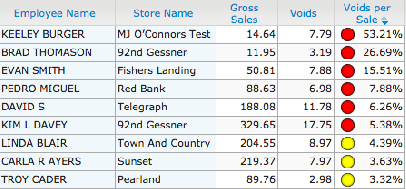Sifting Through It All
Exception Based Reporting is a data analysis process. It compares an incoming stream of information from a system to an established set of data. Then pinpoints items that deviate from the defined norm or exceptions to the rule, so to speak.
These exceptions can be positive or negative. For example, you can easily identify restaurant locations that are performing well and get them to share their secrets with restaurants on the opposite end of the spectrum that need some help.
Exception based reporting systems sift through all your data to find the areas that you need to focus on. Since the software automatically performs these tasks you have time to address and fix the problem.

A restaurant suspects employees are manipulating the point of sale system to steal from the company. With Exception based reporting, they can create a report that shows employees who have too many voids. Thresholds are set that outline what is acceptable or normal. When the report is run, any instances that fall outside the norm would show up on the report. In the manual reporting world, managers would have to go through ALL the details by hand to find the outliers. With Exception based reporting they can program a report to look for the deviations and get an automatic notification when they are found.
Steve Brooks of Tumbleweed describes what exception based reporting is and how it is used in the restaurant industry.
Mirus has long provided a reporting feature that allows decision makers to filter data in a best and worst format. This allows you to see your segmented data in a “top” and/or “bottom” ranking.
Since 1999, Mirus has been used by Operations, Finance, Marketing, and IT.
|
 |
|||||
| System Status | © Copyright 1999-2025 Mirus. All Rights Reserved. |